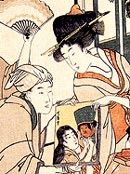

Fading of a Yoshitaki PrintThe image shown below was designed circa 1865-75 by the Osaka artist Ichiyôsai Yoshitaki ( 一養齋芳瀧: 1841-1899). It is the center sheet of a chûban-size triptych depicting three beauties, one on each sheet, spending time together on a verandah while enjoying the cool of the evening at Shijô in Kyoto. This impression was acquired in 1989, when it was first photographed (see the image below left), and then given as a gift to a family member. Notes on an index card were also made at that time regarding the condition of the print (very good, with well-preserved red, yellow, blue, and purple). Within a few weeks of acquisition, the print was matted in archival materials and then displayed in its frame near the corner of a wall about ten feet from a window with shaded exposure (never any direct sunlight). In January 2001, about 12 years after its acquisition, the print was rephotographed (see the image below right) using a different camera, film, and lighting, which accounts for the slight color shift in the background grays. Overall, however, the colors in both images are accurate enough for a comparison of fading (see the technical note near the end of the text).
Even with slight color shifts due to changes in photographic equipment, and also considering the inconsistencies of digital scans, the original slide and handwritten notes confirm a significant loss of colors. The red (probably made with beni or Carthamus tinctorius, a safflower) on the woman's obi and underrobe has shifted to a medium orange-red, causing the bird patterns printed in metallics to stand out in greater contrast against the partly faded red (whereas the red pattern on the fan has lost contrast against the unchanged metallic simulated-silver color). The yellow trim on the railing has shifted to a pale beige. The floral design in purple (possibly made from an aniline dye) has turned to shades of grayish blue, while the green of the flooring (probably a colorant made from a mixture of yellow and blue) has altered, favoring the blue colorant used in the mixture. (One yellow colorant found in ukiyo-e printmaking is orpiment, a mineral pigment that turns into a colorless arsenic oxide when exposed to light. This conversion may be confirmed by testing non-invasively for the presence of arsenic.) Note, however, that the blue on the river in the middle background (probably the relatively colorfast Prussian blue, bero-ai) remains unfaded, as does the sumi (black and gray pigment). Too often we hear or read that when displaying framed works of art on paper, one should simply avoid direct sunlight, as if such a caution would be enough to protect prints from fading. The example shown here confirms what has been known by those with experience: Indirect natural light (as well as incandescent and fluorescent illumination) will also fade Japanese prints. Later examples from well into the nineteenth century will fade (as will twentieth-century prints), though some colorants will change at slower rates than those on ukiyo-e prints from earlier periods. In the case of Yoshitaki's print, barely more than a decade of exposure to moderate ambient natural light and occasional incandescent light was all that was needed to cause obvious fading of a previously well-preserved specimen. Thus not only do we know that fading will occur, but it will happen in a relatively short time, even when a print is framed archivally and not severely abused by placement in sunlight.
For another print by Yoshitaki (unfaded), see Yoshitaki. For an example of the stages of fading in earlier ukiyo-e, see Fading of Red Colorants and Samples of Fading. General Comment: The color shifts in the Yoshitaki impression are fairly typical of mid- to late-nineteenth century ukiyo-e prints. Countless surviving prints show altered shades of red from its original saturated state. It is certainly true that many shades of unfaded red colorants are possible, and indeed ukiyo-e printmakers purposely varied the hues and their saturation for visual effect. Nevertheless, the presence of the orange-red such as the one above right is more often than not a sign of fading. The shift from a medium green (a mixture of yellow and blue) to the bluish green is also frequently encountered in nineteenth-century ukiyo-e prints. Presumably, the yellow colorant in the mixture suffers a photochemical alteration faster than does the blue, which was not the same blue used in earlier ukiyo-e, such as the fugitive aigami, dayflower, or ai, indigo. As cited above, orpiment, a fugitive yellow mineral pigment, will fade when exposed to light, converting into invisible arsenic oxide and leaving only the blue pigment. One artist whose works suffer from such color losses is Utagawa Hiroshige. If one encounters, for example, a Hiroshige landscape with leaves and grass that are blue (or bluish green like on the flooring above right), the chances are that fading has occurred (assuming it is not an aizuri-e, that is, a print purposely made exclusively in shades of blue). Such specimens are typically accompanied by fading in the other fugitive pigments, particularly in Hiroshige's case by attenuated reds in cartouches or other areas of the print. ©2001-2022 by John Fiorillo |
Viewing Japanese Prints |

